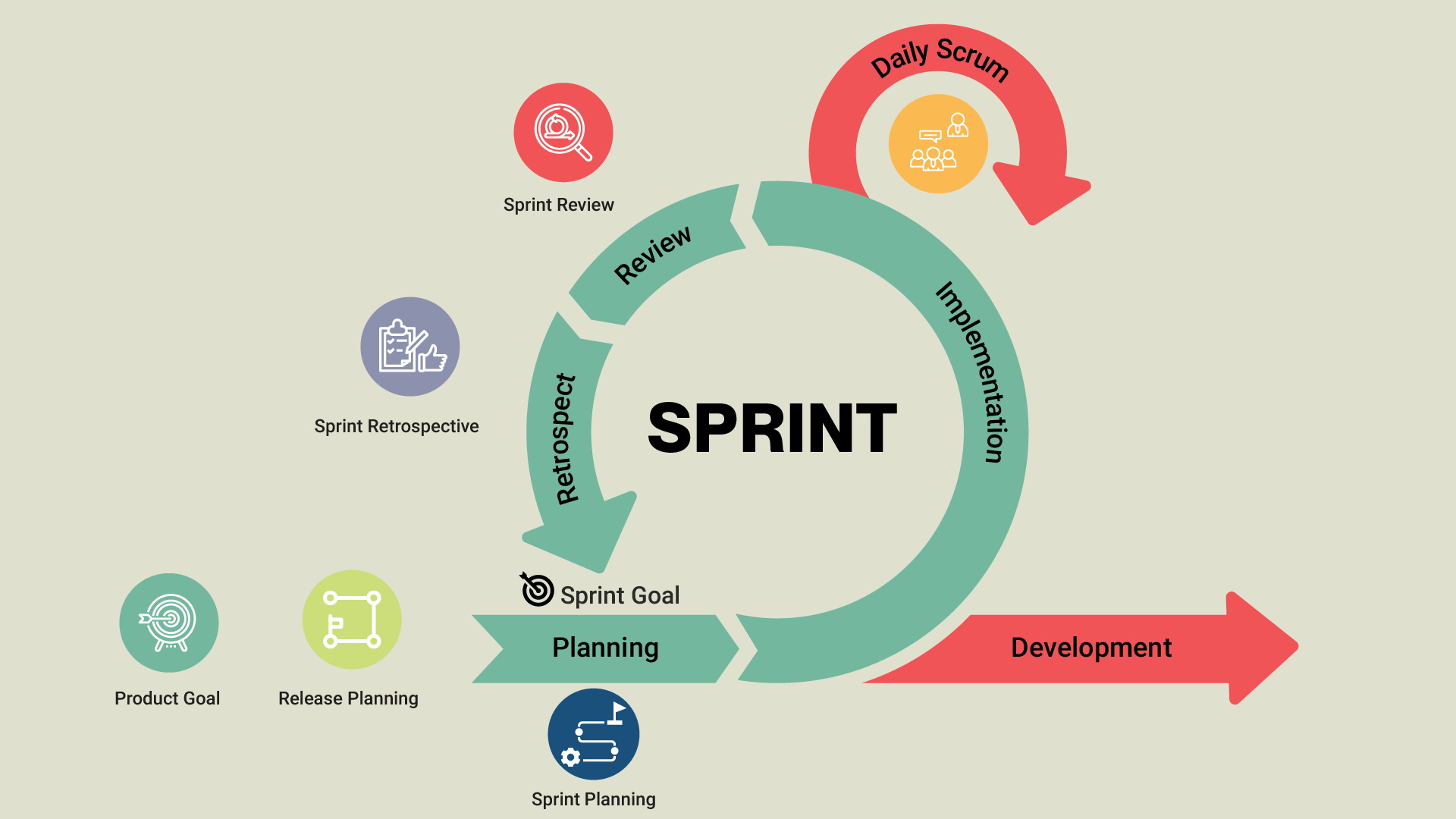
Sprint Itself Is An Event In Scrum? True Or False? 5 Events In Scrum.
Yes, Sprint is itself an event in Scrum. It is an opportunity for the Scrum team (Product Owner + Developers + Scrum Master) to validate its ideas or assumptions. So a sprint can be knowns as a feedback cycle or learning cycle.
Our experts believe, Sprint itself is a bundle of many values. In short, we say SPRINT stand for:
S → Sprint Goal
P → Potentially Releasable Increment
R → Risk mitigation
I → Iterative
N → No Gaps
T → Timeboxed
Let’s snoop into brief of it:
Sprint Goal
Every Sprint should have a Sprint Goal to give the Scrum team a focused direction to move forward. At the same time, it also creates transparent evidence to measure the progress of the outcome (Increment) of the Sprint.
Potentially Releasable Increment
One of the rules in Scrum is, “Every Sprint must produce a valuable and useful Increment.” No matter what, at least a business functionality must be created at the end of the Sprint to concretely validate that the work that the team cares about is taking place.
For example, if you are planning to travel 1000 kilometres, a plan of how to travel and reach doesn’t give real progress, but a journey of 100 kilometres towards 1000 gives you real progress. So the Increment is the real progress towards the goal.
The concept aligns with the Agile Principle; Working software is the primary measure of progress.
Risk mitigation
The Iterative & Incremental approach within a shorter timebox enables the Scrum Team to take tangible evidence to control the risk. In addition, shorter timeboxes keep the risk of cost and effort within a manageable limit.
Iterative
The Sprint is a containing event with multiple events in it. The Sprint is Iterative – all the events happen in a sequence within the Sprint. It starts with Sprint Planning, and then it has Daily Scrum, a recurring event throughout the Sprint. Finally, the Sprint ends with Sprint Review and Sprint Retrospective.
No Gaps
The Sprint creates a rhythm like a heartbeat. A heartbeat starts immediately after a heartbeat. Likewise, a sprint should begin immediately after the conclusion of the previous Sprint. Therefore, Sprint is also known as Heart of Scrum.
Time-Boxed
The Sprint is timeboxed. It should be one month or less. The Scrum team determines the timebox based on the level of uncertainty a business has and the level of uncertainty the implementation of the business holds.
If the uncertainty is too high,
- Business objectives may become obsolete
- Technology innovations may disrupt the market competition
- Laws and regulations may cause changes
The scrum team decides to run shorter sprints to validate the uncertainties faster to ensure they don’t go in the wrong direction for long. In addition, shorter Sprints give the business the flexibility to take possible turns based on frequent learnings.
At the same time, the Sprint should be long enough for the Scrum Team to create a usable increment for concrete validation. So, one must consider both dimensions’ flexibility and stability to determine the Sprint length.
The above context is in line with the Agile principle, Deliver working software frequently, from a couple of weeks to a couple of months, with a preference for the shorter timescale.
Sprint is a container of all other events in Scrum. Sprint contains Sprint Planning, Daily Scrum, Sprint Review, and Sprint Retrospective.
Sprint starts with Sprint Planning. Then, before executing the Sprint, the planning occurs where the team decides the requirements they will work on.
Sprint planning
In the session, the main objective is to choose a Sprint goal. Then, in Sprint Planning, the Product Owner and Developers discuss the number of requirements the developers will pick to achieve the Sprint Goal. Finally, the Developers will commit to the Sprint Goal. The entire Scrum team must attend the meeting. The team can also invite relevant stakeholders to the event if some additional expertise is required.
Daily Scrum
Daily Scrum is a timeboxed event of 15 minutes. The Developers create a plan for the next 24 hours and synchronize their activities. These daily meetings let the team members keep up without spending much time in long meetings.
A quick focus on all discussions, plans, and problems is done in this meeting.
Sprint Review
This event is on the last day of the Sprint to inspect increments or outcomes of the Sprint. The Scrum team (The Developers, the Product Owner, & the Scrum Master) and the Stakeholders (Customers, end users etc.) attend this meeting. In these Sprint Reviews, the Increments ( Requirements that the team completed and representing value) are demonstrated to the customers and stakeholders.
The Scrum team receives feedback on the outcome of the Sprint. What is DONE and what isn’t DONE with respect to the Increment is discussed.
Sprint Retrospective
At the end of the Sprint, the Scrum team takes time to look back on the happenings of the Sprint with respect to their interactions, relationships, behaviours, processes, etc. They also specifically discuss the improvements in quality or compliance standards that the team needs to adhere to. This event is an improvement meeting for the entire Scrum team.
Conclusion
The Scrum team uses the Sprint to create a useful and valuable Increment that accomplishes the Sprint Goal. The Increment is the ultimate artifact of transparency, and it is what enables true agility.




